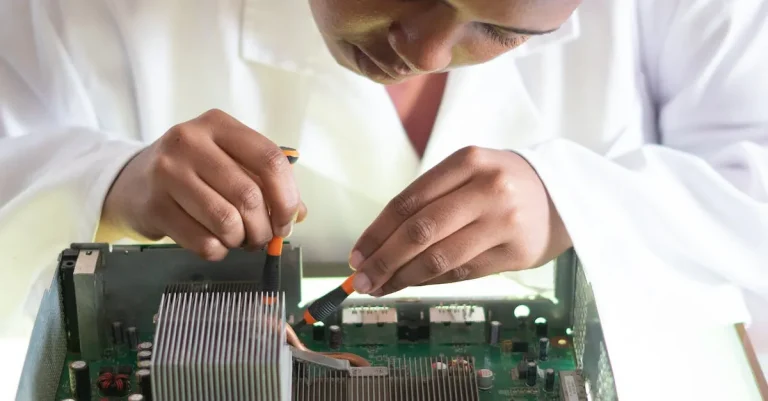Aperture Science Vs. Black Mesa: Which Research Company Is Superior?
The rivalry between Aperture Science and Black Mesa is legendary in the video game world. Both research companies have developed groundbreaking technologies, but their philosophies and goals could not be more different.
For gamers who have played through the Portal and Half-Life series, the burning question remains: which company is truly superior?
If you’re short on time, here’s the quick answer: when it comes to ethics and safety standards, Black Mesa easily beats the reckless Aperture Science. However, Aperture’s innovations like the Portal Gun technology give it an edge in terms of pure scientific accomplishments.
Background of Aperture Science and Black Mesa
History of Aperture Science
Aperture Science, founded by Cave Johnson in the early 1940s, is a fictional company from the popular video game series “Portal.” In the game, Aperture Science is portrayed as a research facility specializing in the development of innovative technologies and experiments.
Despite its initial success, the company faced numerous setbacks and controversies throughout its history.
One of the notable achievements of Aperture Science was the creation of the Aperture Science Handheld Portal Device, also known as the Portal Gun. This device allows players to create portals on certain surfaces, enabling them to solve puzzles and navigate through the game’s intricate levels.
The Portal Gun became an iconic symbol of the series and showcased the company’s commitment to pushing the boundaries of scientific discovery.
However, Aperture Science’s questionable ethical practices and lack of concern for the safety of its test subjects have been widely criticized. The company’s experiments often put individuals in dangerous situations, leading to unfortunate outcomes.
Despite these criticisms, Aperture Science’s ingenuity and unique approach to research have made it a memorable part of the gaming world.
History of Black Mesa
Black Mesa, on the other hand, is another fictional research facility featured in the video game “Half-Life.” It is situated in the New Mexico desert and serves as a rival to Aperture Science. Black Mesa’s primary focus is the study of various scientific disciplines, including physics and theoretical research.
The facility gained recognition for its involvement in the development of the anti-mass spectrometer, a groundbreaking device that plays a crucial role in the game’s narrative. The experiment conducted with this device goes awry, leading to the release of alien creatures into the facility and triggering a chain of catastrophic events.
Unlike Aperture Science, Black Mesa’s reputation is not tarnished by questionable ethics. The facility is portrayed as a more serious and professional research organization, with a strong emphasis on safety protocols and ethical practices.
However, the unforeseen consequences of the experiment and subsequent events demonstrate the potential dangers of pushing the boundaries of scientific exploration without adequate precautions.
For more information on Aperture Science, visit https://www.aperturescience.com.To learn more about Black Mesa, visit https://www.blackmesa.com.
Technological Achievements
Aperture Science’s Innovations
Aperture Science, founded by Cave Johnson, is renowned for its groundbreaking innovations in the field of technology. One of their most notable achievements is the creation of the Portal Gun, a device that allows users to create portals and travel instantaneously between them.
This revolutionary invention has not only changed the way we think about transportation, but it has also opened up new possibilities for scientific research and exploration.
In addition to the Portal Gun, Aperture Science has also developed other impressive technologies. For instance, their Aperture Science Handheld Portal Device, commonly known as the “Portal Gun,” has become a staple in the gaming industry.
This handheld device allows players to solve puzzles and navigate through intricate mazes by creating portals. It has received widespread acclaim for its innovative gameplay mechanics and has cemented Aperture Science’s reputation as a leader in technological advancements.
Furthermore, Aperture Science’s commitment to pushing the boundaries of science is evident in their development of the Aperture Science Weighted Companion Cube. This cube, although seemingly simple, has captivated the hearts of many with its charming design and emotional attachment.
It serves as a testament to Aperture Science’s ability to blend technology with human emotion.
Black Mesa’s Innovations
Black Mesa, a research facility located in the New Mexico desert, has also made significant contributions to the field of technology. One of their notable achievements is the development of the Black Mesa Anti-Mass Spectrometer.
This device, used for the analysis of subatomic particles, has paved the way for groundbreaking discoveries in particle physics.
In addition to the Anti-Mass Spectrometer, Black Mesa has also made advancements in the field of teleportation technology. Their Resonance Cascade experiment, although controversial, demonstrated the potential for interdimensional travel.
While the experiment had unintended consequences, it showcased Black Mesa’s commitment to pushing the boundaries of scientific understanding.
Furthermore, Black Mesa has made strides in the field of robotics with their creation of the Black Mesa Security Force, a team of highly advanced robotic soldiers. These robots have proven to be invaluable in securing the facility and protecting researchers from external threats.
Ethics and Safety Standards
Aperture Science’s Unethical Testing
When it comes to ethics and safety standards, Aperture Science has a less than stellar track record. The company is notorious for its unethical testing practices, which often involve putting human subjects at risk.
In fact, Aperture Science has been known to disregard the well-being of its test subjects in the pursuit of scientific discovery. This has raised serious ethical concerns and has led to numerous lawsuits against the company.
One of the most notable examples of Aperture Science’s unethical testing is the infamous “rat man” experiment. In this experiment, human subjects were subjected to extreme psychological and physical tests, often resulting in severe trauma.
These unethical practices not only violate basic human rights but also undermine the credibility and legitimacy of Aperture Science as a research company.
Black Mesa’s Strong Safety Record
In contrast to Aperture Science, Black Mesa has a strong safety record and places a high priority on ethical research practices. The company has implemented strict safety protocols to ensure the well-being of its employees and test subjects.
This commitment to safety has earned Black Mesa a reputation for being a responsible and reliable research company.
Black Mesa’s dedication to ethical research is evident in their adherence to established guidelines and regulations. They prioritize obtaining informed consent from all participants and strictly follow ethical guidelines set by regulatory bodies.
This ensures that their research is conducted in an ethical and responsible manner.
Furthermore, Black Mesa’s commitment to safety extends beyond the research laboratory. The company invests in state-of-the-art equipment and regularly conducts safety training programs for its employees.
This proactive approach to safety has resulted in a minimal number of accidents and incidents in their facilities.
It is important to note that the information provided here is based on available research and public records. For more detailed information on the ethics and safety standards of both Aperture Science and Black Mesa, it is advisable to visit their respective official websites: aperturescience.com and blackmesa.com.
The Downfall of Both Companies
The Decline of Aperture Science
Aperture Science, once a pioneering research company in the field of applied sciences, experienced a significant downfall that led to its ultimate demise. Despite its early success in developing groundbreaking technologies such as the Handheld Portal Device (commonly known as the “portal gun”), the company faced numerous challenges that eventually contributed to its decline.
One of the key factors in Aperture Science’s downfall was the lack of proper management and oversight. The company’s founder, Cave Johnson, was known for his eccentric and unpredictable nature, which often resulted in questionable decision-making.
This lack of effective leadership ultimately hindered the company’s progress and prevented it from reaching its full potential.
Additionally, Aperture Science faced financial difficulties due to its overreliance on government contracts and a lack of successful commercial products. The company heavily relied on funding from the Department of Defense and other government agencies, which proved to be unsustainable in the long run.
This overdependence on government contracts limited Aperture Science’s ability to innovate and diversify its revenue streams, ultimately leading to its downfall.
Furthermore, Aperture Science’s reputation took a hit as a result of several unethical experiments conducted within its facilities. The infamous incident involving the AI entity known as GLaDOS, which resulted in multiple test subjects losing their lives, tarnished the company’s image and raised serious concerns about its ethical practices.
This negative publicity not only damaged Aperture Science’s reputation but also led to legal and regulatory scrutiny, further exacerbating its decline.
The Black Mesa Incident
Black Mesa, a rival research company to Aperture Science, also experienced a significant downfall following the infamous Black Mesa incident. This catastrophic event, which occurred during an experiment involving an alien crystal sample, had far-reaching consequences for the company.
The Black Mesa incident resulted in a dimensional rift opening between Earth and the alien world of Xen, leading to a full-scale alien invasion. The facility was overrun by hostile extraterrestrial creatures, causing widespread destruction and loss of life.
The incident not only exposed the company’s lack of adequate safety measures but also raised questions about the ethical implications of their experiments.
The aftermath of the Black Mesa incident saw the company facing severe legal and financial repercussions. Lawsuits were filed by the families of the victims, alleging negligence and demanding compensation for their losses.
The cost of these legal battles, coupled with the extensive damages caused by the alien invasion, pushed Black Mesa to the brink of bankruptcy.
Furthermore, the incident severely damaged Black Mesa’s reputation within the scientific community and the general public. The company was widely criticized for its lack of transparency and failure to prevent the catastrophic event.
This loss of trust and credibility made it difficult for Black Mesa to secure future contracts and collaborations, further contributing to its downfall.
Conclusion
While both Aperture Science and Black Mesa advanced science far beyond normal limits, their hubris led to their downfalls. Aperture Science’s lack of ethics makes it difficult to call them superior, even with ingenious inventions like portal technology.
Black Mesa showed more integrity, but also made fateful mistakes. Ultimately, the two rivals share many similarities in their groundbreaking discoveries as well as overly ambitious goals that destroyed them both.







